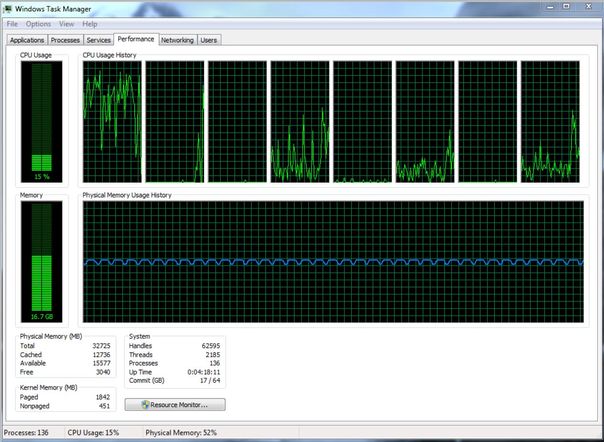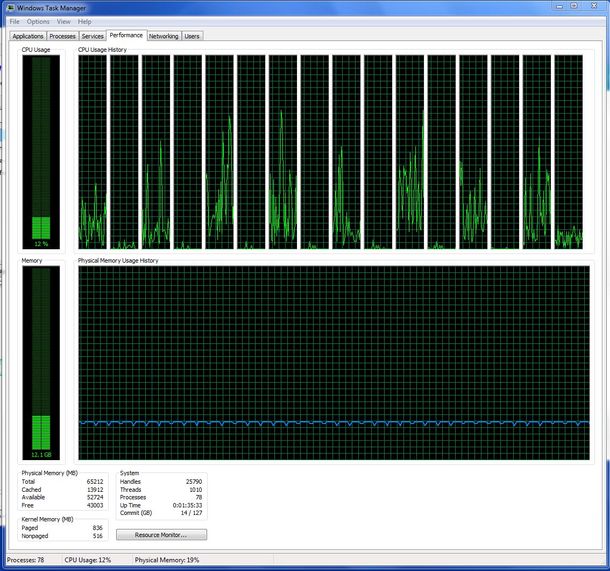Community Tip - When posting, your subject should be specific and summarize your question. Here are some additional tips on asking a great question. X
- Community
- Creo Elements Direct
- Drafting
- Model Manager Load Performance
- Subscribe to RSS Feed
- Mark Topic as New
- Mark Topic as Read
- Float this Topic for Current User
- Bookmark
- Subscribe
- Mute
- Printer Friendly Page
Model Manager Load Performance
- Mark as New
- Bookmark
- Subscribe
- Mute
- Subscribe to RSS Feed
- Permalink
- Notify Moderator
Model Manager Load Performance
Our current workstations have 32 GB of memory. When loading a large assembly from Model Manager I find that SolidDesigner appears to limit itself to using less than 10 GB of memory (see the first screenshot below). The wave pattern of memory usage looks like the software needs more memory but instead of taking memory that is available it is dumping some memory already in use.
I have a new workstation that has 64 GB of memory installed but SolidDesigner still appears to limit itself to under 10 GB of memory when loading from Model Manager (see the second screenshot below). Is there a setting somewhere that is limiting how much memory Creo can use? I was hoping to see an improvement in load times with this new computer but I am not seeing improvement.
- Labels:
-
Data Exchange
- Mark as New
- Bookmark
- Subscribe
- Mute
- Subscribe to RSS Feed
- Permalink
- Notify Moderator
@DanAdler wrote:
Our current workstations have 32 GB of memory. When loading a large assembly from Model Manager I find that SolidDesigner appears to limit itself to using less than 10 GB of memory (see the first screenshot below). The wave pattern of memory usage looks like the software needs more memory but instead of taking memory that is available it is dumping some memory already in use.
I have a new workstation that has 64 GB of memory installed but SolidDesigner still appears to limit itself to under 10 GB of memory when loading from Model Manager (see the second screenshot below). Is there a setting somewhere that is limiting how much memory Creo can use? I was hoping to see an improvement in load times with this new computer but I am not seeing improvement.
There is no 10 GB limit in the Software - I had examples where Modeling (I used V19) grew to >30 GB
Concerning your impression that Modeling "seems to have a limit".
When loading a large Model, the following happens:
- Model Manager collects all´data - Modeling is "idle" (and does not grow)
- When all files have been transferred to the local disk - Modeling starts to load and is growing rapidly
- Then Modeling seems to "stall" - but it is still running at 100%
(=using *one* core at 100% - if you have 8 cores, Modeling is displayed as 12,5% CPU)
In this phase, a lot of processing and building the graphics model is done - this allocates some
memory, but other memory used to load/convert the data is re-used - so it appears that Modeling
has a memory limit)
- As said, I have cases where Modeling grows above 30 GB - but with the same "pattern"
of memory over time as you describe.
Question: How much RAM is Modeling using when the Model is actually loaded?
My guess: approx. 10 GB - would mean that this is the size occupied by the Model.
Hope this helps
Regards, Max
- Mark as New
- Bookmark
- Subscribe
- Mute
- Subscribe to RSS Feed
- Permalink
- Notify Moderator
Thanks for your reply @MaxR.Kublin.
What is happening when Modeling is actually loading the model after the files have been transferred over to the local disk? I ask because this step when loading from Model Manager takes about 30 minutes for a particular assembly. When I save the same assembly to the local disk as a pkg file it takes just 3 minutes to open in Modeling.
I guess what I'm most interested in is where is my bottleneck? What could we do to improve the load times of our large assembles?
- Mark as New
- Bookmark
- Subscribe
- Mute
- Subscribe to RSS Feed
- Permalink
- Notify Moderator
I studied the process running while ModelManager is moving the files from the server to the local drive. Each and every file brought over is inspected by our antivirus software. This is the bottleneck.
regards
Tom
- Mark as New
- Bookmark
- Subscribe
- Mute
- Subscribe to RSS Feed
- Permalink
- Notify Moderator
Interesting. I will stop the antivirus software and try a load from Model Manger. I would not be surprised to find that it is my bottleneck too. Thanks for your response.
- Mark as New
- Bookmark
- Subscribe
- Mute
- Subscribe to RSS Feed
- Permalink
- Notify Moderator
What were your results with stopping the virus scanner?
Thanks
Tom
- Mark as New
- Bookmark
- Subscribe
- Mute
- Subscribe to RSS Feed
- Permalink
- Notify Moderator
You may have two bottlenecks when Virus Scanning is active:
a) On the Server (File Server).
When the file area(s) are part of Virus Scanning, each file will (Models, Drawings, Thumbnails etc.)
are being scanned by the Virus Scanner. This may significantly reduce performance for *all* users.
b) On the Client Workstations/Laptops
Files (Drawings, Models, Thumbnails (!)) are being transferred from the File Server to a temporary
directory on the Client. This is something you already found out.
It is a good idea to check a) as well.







